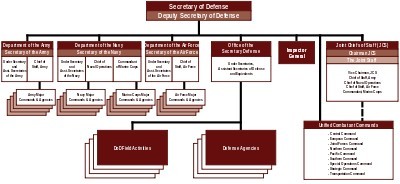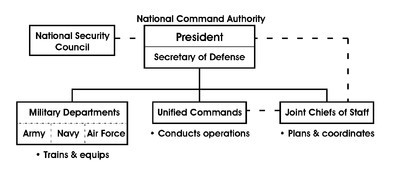
United States Secretary of Defense
Wikipedia | 2013-11-29 14:37
The Secretary of Defense (SecDef) is the head and chief executive officer of the Department of Defense, an Executive Department of the Government of the United States of America. This position corresponds to what is generally known as a Defense Minister in many other countries. The Secretary of Defense is appointed by the President with the advice and consent of the Senate, and is by custom a member of the Cabinet and by law a member of the National Security Council.
Secretary of Defense is a statutory office, and the general provision in 10 U.S.C. § 113 provides that the Secretary of Defense has "authority, direction and control over the Department of Defense", and is further designated by the same statute as "the principal assistant to the President in all matters relating to the Department of Defense."
Ensuring civilian control of the military, an individual may not be appointed as Secretary of Defense within seven years after relief from active duty as a commissioned officer of a regular (i.e., non-reserve) component of an armed force.
Ensuring civilian control of the military, an individual may not be appointed as Secretary of Defense within seven years after relief from active duty as a commissioned officer of a regular (i.e., non-reserve) component of an armed force.
The Secretary of Defense is in the chain of command and exercises command and control, subject only to the orders of the President, over all Department of Defense forces (the Army, Navy, Air Force, and Marine Corps) for both operational and administrative purposes. Only the Secretary of Defense (or the President) can authorize the transfer of operational control of forces between the three Military Departments (Departments of the Army, Navy & Air Force) and the currently nine Combatant Commands (Africa Command, Central Command, European Command, Northern Command, Pacific Command, Southern Command, Special Operations Command, Strategic Command, Transportation Command), and between the Combatant Commands. Because the Office of Secretary of Defense is vested with legal powers which exceeds those of any commissioned officer, and is second only to the Office of President in the military hierarchy, it has sometimes unofficially been referred to as a de facto "deputy commander-in-chief".[17][18][19] The Chairman of the Joint Chiefs of Staff is the principal military adviser to the Secretary of Defense and the President, and while the Chairman may assist the Secretary and President in their command functions, the Chairman is not in the chain of command.
The Secretary of Defense, Secretary of State, the Attorney General and the Secretary of the Treasury, are generally regarded as the four most important cabinet officials because of the importance of their departments. Secretary of Defense is a Level I position of the Executive Schedule and thus earns a salary of $199,700 per year. The current Secretary is Leon Panetta who assumed office July 1, 2011.
History

Seal of the National Military Establishment (1947–1949), which was reorganized into the Department of Defense.
The Army, Navy, and Marine Corps were established in 1775, in concurrence with the American Revolution. The War Department, headed by the Secretary of War, was created by Act of Congress in 1789 and was responsible for both the Army and Navy until the founding of a separate Department of the Navy in 1798.
Based on the experiences of World War II, proposals were soon made on how to more effectively manage the large combined military establishment over which only the President had direct line authority. The Army generally favored centralization while the Navy had institutional preferences for decentralization and the status quo. The resulting National Security Act of 1947 was largely a compromise between these divergent viewpoints. The Act split the War Department into the Department of the Army and the Department of the Air Force, each with their own Secretary, and created a sui generis National Military Establishment led by a Secretary of Defense. At first, each of the service secretaries maintained quasi-cabinet status. The first Secretary of Defense, James Forrestal, who in his previous capacity as Secretary of the Navy had opposed creation of the new position, found it difficult to exercise authority over them with the limited powers his office had at the time. To address this and other problems, the National Security Act was amended in 1949 to further consolidate the national defense structure in order to reduce interservice rivalry, directly subordinate the Secretaries of the Army, the Navy and the Air Force to the Secretary of Defense in the chain of command, and rename the National Military Establishment to the Department of Defense as one Executive Department. The position of the Deputy Secretary of Defense, the number two position in the department, was also created at this time.
The general trend since 1949 has been to further centralize management in the Department of Defense, elevating the status and authorities of civilian OSD appointees and defense-wide organizations at the expense of the military departments and the services within them. The last major revision of the statutory framework concerning the position was done in the Goldwater–Nichols Department of Defense Reorganization Act of 1986. In particular, it elevated the status of joint service for commissioned officers, making it in practice a requirement before appointments to general officer and flag officer grades could be made.
Powers and functions

DoD organization chart (2005.)

Functional chart of the major DoD components, and their relations to the President and the NSC.
In the U.S. Armed Forces, the Secretary of Defense is often referred to as SecDef or SD. The Secretary of Defense and the President together constitute the National Command Authorities (NCA), which has sole authority to launch strategic nuclear weapons. All nuclear weapons are governed by this dual-authority – both must concur before a strategic nuclear strike may be ordered.
The Secretary's staff element is called the Office of the Secretary of Defense (OSD) and is composed of a Deputy Secretary of Defense (DEPSECDEF) and five Under Secretaries of Defense in the fields of Acquisition, Technology & Logistics; Comptroller/Chief Financial Officer; Intelligence; Personnel & Readiness; and Policy.
The Secretary of Defense by statute also exercises "authority, direction and control" over the three Secretaries of the military departments (Secretary of the Army, Secretary of the Navy, and Secretary of the Air Force), the Chairman of the Joint Chiefs of Staff, the other members of the Joint Chiefs of Staff (Vice Chairman of the Joint Chiefs of Staff, Army Chief of Staff, Commandant of the Marine Corps, Chief of Naval Operations, and Air Force Chief of Staff), the Combatant Commanders of the Unified Combatant Commands, the Directors of the Defense Agencies (for example the Director of the National Security Agency) and of the DoD Field Activities. All of these high-ranking positions require Senate confirmation.
The Secretary is one of few civilians who is authorized to act as convening authority in the military justice system for General Courts-Martial (10 U.S.C. § 822: article 22, UCMJ), Special Courts-Martial (10 U.S.C. § 823: article 23, UCMJ), and Summary Courts-Martial (10 U.S.C. § 824: article 24 UCMJ).
List of Secretaries of Defense
The longest-serving Secretary of Defense is the late Robert McNamara, who served for a total of 2,595 days. Combining his two non-sequential services as Secretary of Defense, the second longest serving is Donald Rumsfeld, who served merely ten days fewer than McNamara.
| No. | Name | State of Residence | Took Office | Left Office | Days served |
President serving under |
||
| 1 | James Vincent Forrestal | New York | September 19, 1947 | March 19, 1949 | 558 | Harry S. Truman | ||
| 2 | Louis Arthur Johnson | West Virginia | March 28, 1949 | September 19, 1950 | 540 | |||
| 3 | George Catlett Marshall, Jr. | Pennsylvania | September 19, 1950 | September 19, 1951 | 365 | |||
| 4 | Robert Abercrombie Lovett | New York | September 19, 1951 | January 20, 1953 | 491 | |||
| 5 | Charles Erwin Wilson | Michigan |
January 20, 1953 |
October 8, 1957 | 1,722 | Dwight D. Eisenhower | ||
| 6 | Neil Hosler McElroy | Ohio | October 9, 1957 | December 1, 1959 | 783 | |||
| 7 | Thomas Sovereign Gates, Jr. | Pennsylvania | December 2, 1959 | January 20, 1961 | 415 | |||
| 8 | Robert Strange McNamara | Michigan | January 21, 1961 | February 29, 1968 | 2,595 | John F. Kennedy | ||
| Lyndon B. Johnson | ||||||||
| 9 | Clark McAdams Clifford | Maryland | March 1, 1968 | January 20, 1969 | 326 | |||
| 10 | Melvin Robert Laird | Wisconsin | January 22, 1969 | January 29, 1973 | 1,469 | Richard Nixon | ||
| 11 | Elliot Lee Richardson | Massachusetts | January 30, 1973 | May 24, 1973 | 114 | |||
| – |
William Perry Clements, Jr. (as Deputy Secretary) |
Texas | May 24, 1973 | July 2, 1973 | 39 | |||
| 12 | James Rodney Schlesinger | Virginia | July 2, 1973 | November 19, 1975 | 870 | |||
| Gerald Ford | ||||||||
| 13 | Donald Rumsfeld | Illinois | November 20, 1975 | January 20, 1977 | 427 | |||
| 14 | Harold Brown | California | January 21, 1977 | January 20, 1981 | 1,460 | Jimmy Carter | ||
| 15 | Caspar Willard Weinberger | California | January 21, 1981 | November 23, 1987 | 2,497 | Ronald Reagan | ||
| 16 | Frank Charles Carlucci III | Virginia | November 23, 1987 | January 20, 1989 | 424 | |||
| – |
William Howard Taft IV (as Deputy Secretary) |
Ohio | January 20, 1989 | March 20, 1989 | 59 | George H. W. Bush | ||
| 17 | Richard Bruce Cheney | Wyoming | March 21, 1989 | January 20, 1993 | 1,402 | |||
| 18 | Leslie Aspin, Jr. | Wisconsin | January 21, 1993 | February 3, 1994 | 378 | Bill Clinton | ||
| 19 | William James Perry | Pennsylvania | February 3, 1994 | January 24, 1997 | 1,085 | |||
| 20 | William Sebastian Cohen | Maine | January 24, 1997 | January 20, 2001 | 1,457 | |||
| 21 | Donald Rumsfeld | Illinois | January 20, 2001 | December 18, 2006 | 2,158 | George W. Bush | ||
| 22 | Robert M. Gates | Texas | December 18, 2006 | July 1, 2011 | 1,643 | |||
| Barack Obama | ||||||||
| 23 | Leon Panetta | since July 1, 2011 | To Date | |||||
Share this page



















